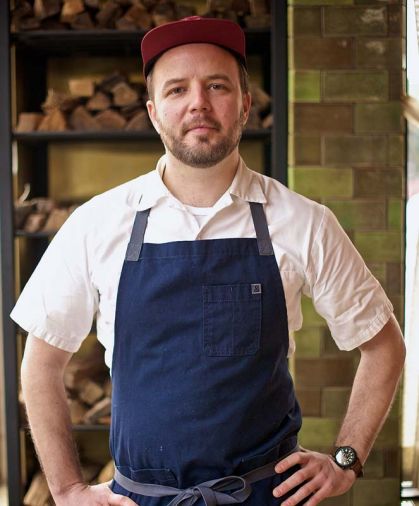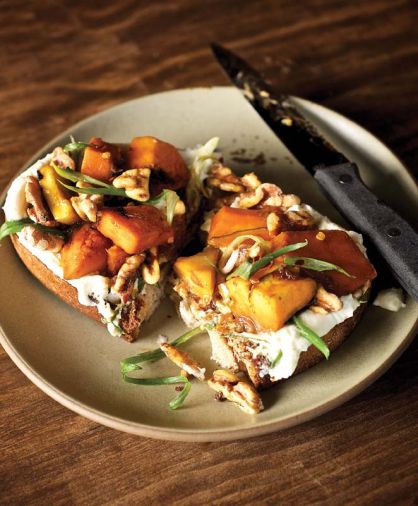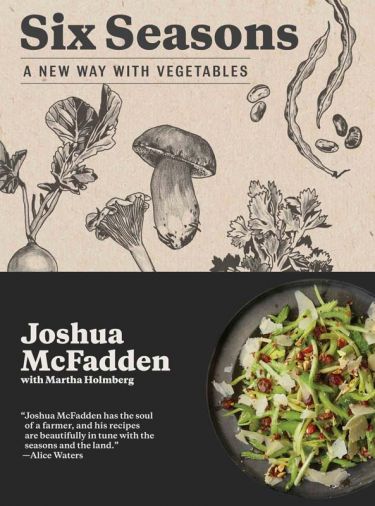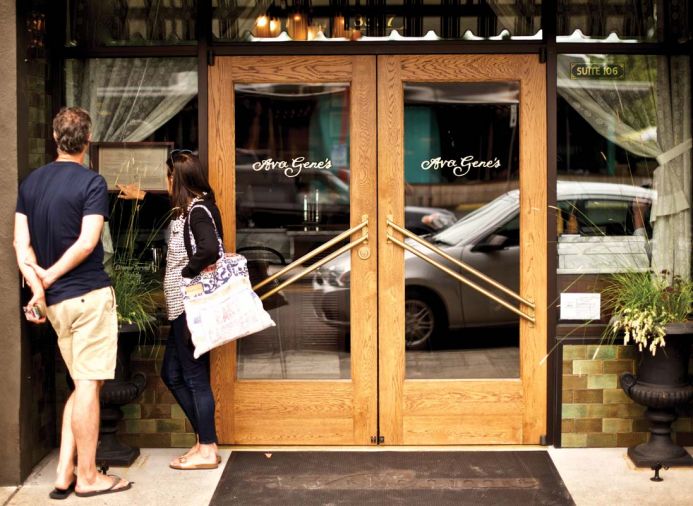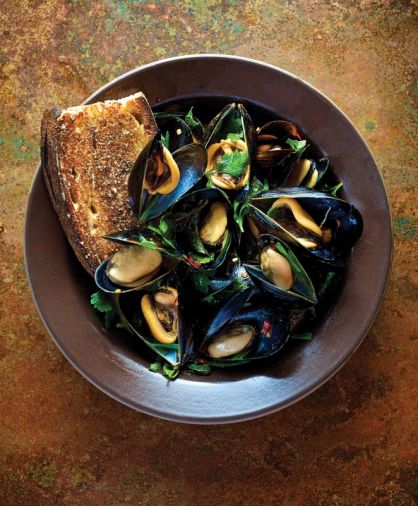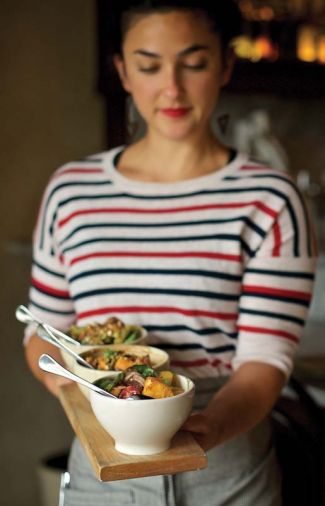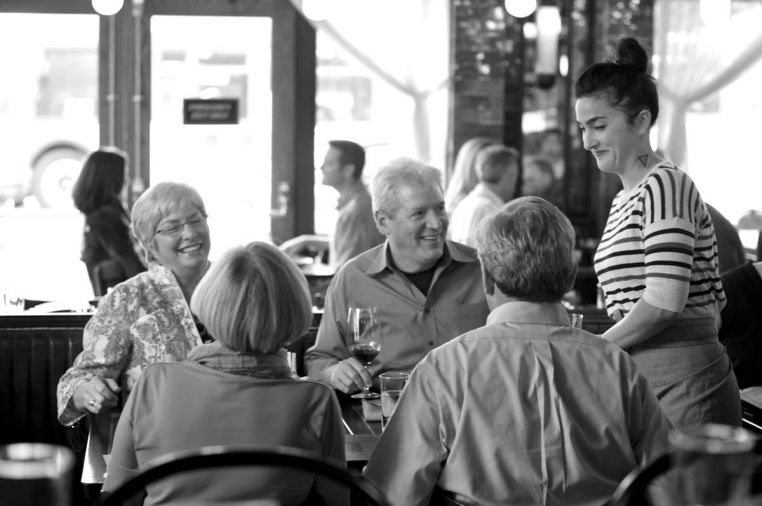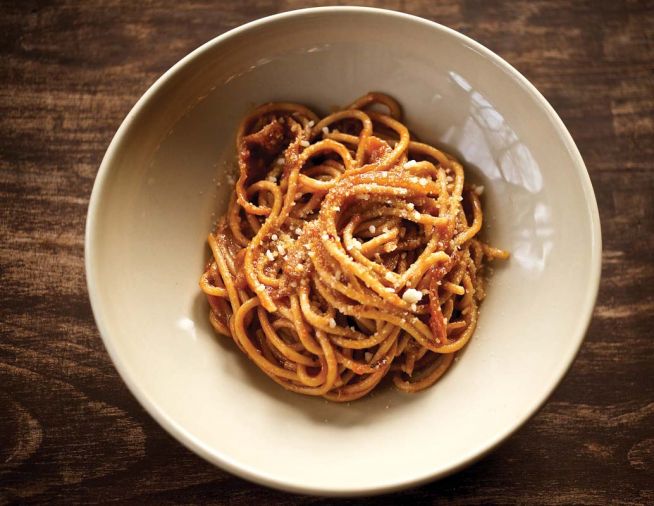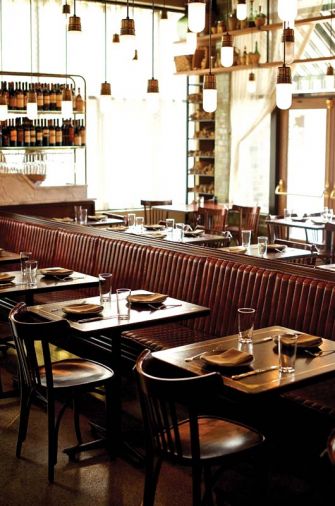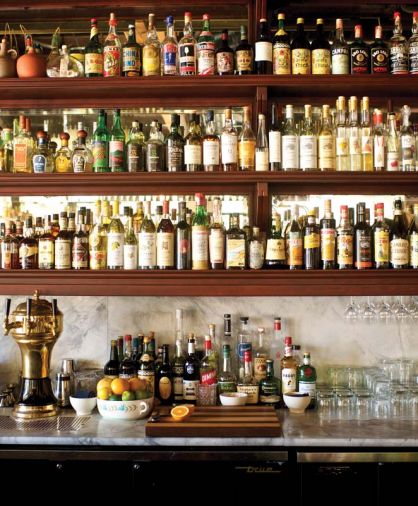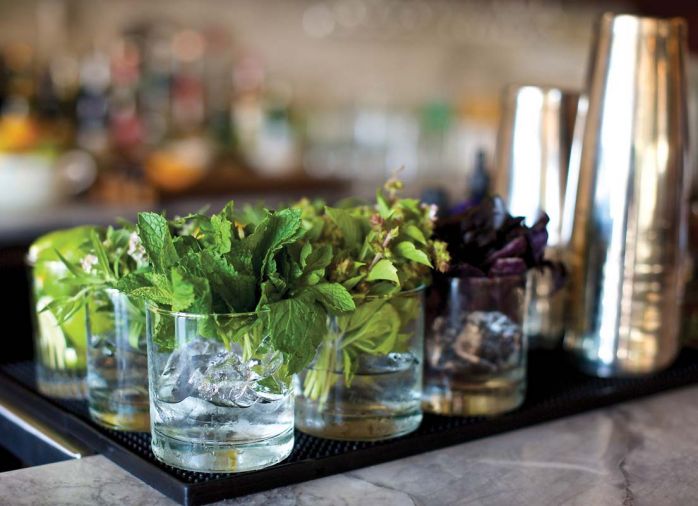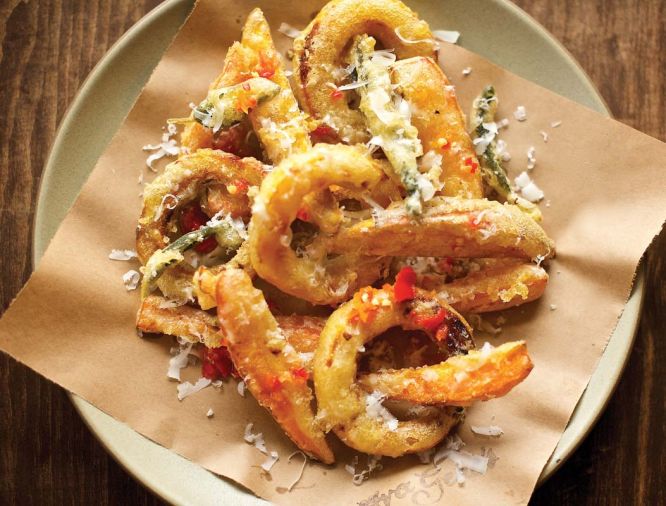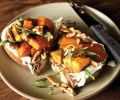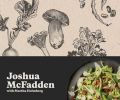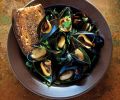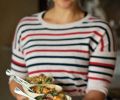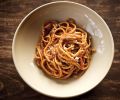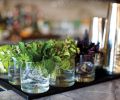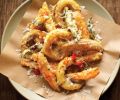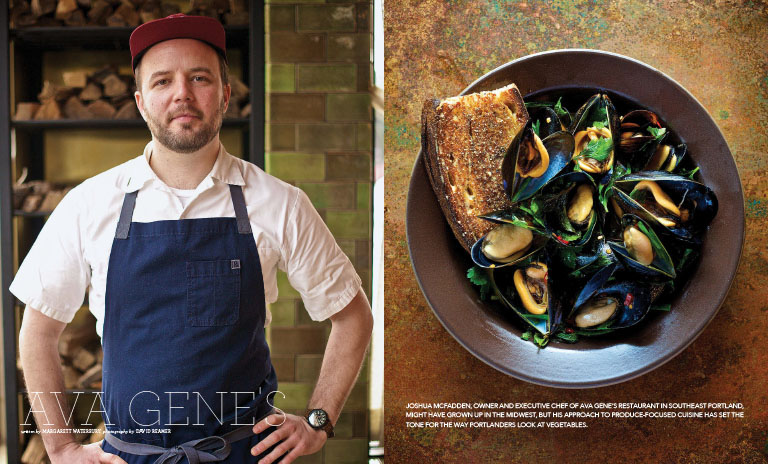There’s an ageless quality about Ava Gene’s. Although its menu is fresh and contemporary, it feels as if the restaurant has existed for a very long time. It hasn’t, although in Portland’s super hot restaurant market, the nearly five years it’s held court on the corner of SE 34th and Division might as well be an eternity. Ava Gene’s has not only become one of Portland’s most beloved restaurants, it’s also entered the national stage as an emblem of a new approach to fine dining that puts vegetables at the center of the plate, and pays as much homage to local producers as it does to European tradition.
It’s impossible to talk about Ava Gene’s without talking about local produce. Although it’s far from a vegetarian restaurant, the menu has always skewed heavily towards vegetables, and Joshua’s distinctive style has inspired dozens of other chefs to experiment with the incredible range of local fruits and vegetables available in the Pacific Northwest. In fact, he’s about to inspire a much wider audience: Joshua’s first cookbook, Six Seasons: A New Way With Vegetables, will be published in the spring of 2017 by Artisan Books.
“Vegetables have always spoken to me: the diversity of colors, textures, seasonality, complexity” Joshua explains. “I couldn’t live without hamburgers, so it’s not like I’m a vegetarian. It’s just that I think finding a moment to just blow somebody’s mind with vegetables is really fun.” And it’s true. If you’re one of the many, many Americans who’ve always found vegetables a little…ho hum, you’re in for a spectacular treat at Ava Gene’s.
One of the reasons that veggie-heavy approach works so well is Joshua’s fanaticism about sourcing exceptional locally grown products. Since its founding in 2012, Ava Gene’s has purchased more than 66,400 pounds of local produce— by the time you read this magazine, the total will likely be several hundred pounds more.
Why pay so much attention to local sourcing? “It all starts with flavor,” explains Joshua. “Local just tastes better. That’s it. It’s fresher, there’s better product, and it’s more fun. All the positives that naturally stem off of that are rewarding as well, but it starts with flavor, always.”
Over the years, Ava Genes has developed long-term relationships with dozens of local farmers—in fact, there’s a whole section on the menu devoted to spotlighting a rotating cast of Oregon and Washington producers. The vendor list reads like a greatest hits track list of farmer’s market stalwarts, from Kiokawa Family Orchards in Hood River to Groundwork Organics in Junction City. One of Joshua’s favorite farms, though, is Ayers Creek, located in Gaston, Oregon, and owned by Anthony and Carol Boutard. “Anthony does everything the hard way, and he’s grown some of the best things I’ve ever had on the planet Earth,” says Joshua. “Ava Gene’s wouldn’t be the restaurant it is without him; his products are so special.”
Heavily seasonal, Ava Gene’s menu changes daily, but no matter when you go, expect surprising preparations, unusual vegetables, and revelatory combinations of peak season produce that draws no hard line between fruits and vegetables. Oregon’s whole bounty, from field to orchard, is given equal footing on this menu. On recent nights, buttery pears rubbed shoulders with crisp, aromatic fennel and lively citrus. In another dish, sweet apples and cabbage got a leg up from prosciutto and provolone. The “Tuscan Cavalry,” a salad made with lacinato kale buried under a shower of SarVecchio cheese (a 20-month Parmesan-style cheese from Wisconsin) and crisp breadcrumbs, hasn’t been taken off the menu in years—take that, kale salad haters.
Of course, vegetables aren’t the whole story. Ava Gene’s is also known for its phenomenal pasta dishes. All of the restaurant’s pasta is made in house, including hand-formed shapes like tortellini and farfalle, die-cut shapes like spaghetti and tagliatelle, and extruded shapes like rotini and campanelle. Not content to stick with tradition, the restaurant’s pasta chef, JoMarie Pitino, regularly experiments with alternative grains like barley, spelt, and buckwheat to give pasta extra heft and flavor. Right now, Ava Gene’s has one pasta machine; Joshua plans to add a second soon to keep up with demand.
“We get people saying they make pasta at home. Well, everybody makes pasta at home,” laughs Joshua. “I love the idea that we can make the best pasta they’ve ever had. People say ‘I don’t even know how you did that!’ It’s simple, but it’s so much better than they were expecting. That’s fun.” A small, attractive selection of entrees often includes seafood and pork, all of which are accompanied by thoughtful vegetable sides. For the adventurous—or simply indecisive—a “family meal” option lets you cede control to the kitchen and enjoy a meal selected by the chef.
While the vast majority of the food served at Ava Gene’s is sourced from local farmers, don’t expect to see any Oregon pinot on the menu. Every single bottle of wine in the restaurant comes from Italy, and the extensive list is organized by region as well as style. “Wine is one of those things, like coffee or chocolate or cheese, that can and should travel,” says Joshua. “Since we’re doing local food, we wanted diners to be able to taste the regions of Italy through wine.” Most wines are organic, biodynamic, sustainably produced, and naturally fermented, and Ava Gene’s is home to what must be one of Oregon’s largest selections of orange wines, a unique style that sees white wine grapes fermented on their skins, much like red wine.
If the delicious food weren’t enough, Ava Gene’s interior is also full of delightful surprises. Although it’s firmly contemporary in style, artful nods to the old world give the space a vaguely continental feel. Inside, nearly floor to ceiling windows illuminate a timeless interior swathed in romantic lace curtains and subtly varied olive green subway tiles, and lush vines spill down shelving around the perimeter of the room lined with empty amari bottles and pannetone packaged in bright paper and fibrous twine.
The dining room is bisected by a leather-coated banquette that runs nearly the entire length of the restaurant; on either side, neat rows of mahogany tables set with brass inlay are arranged underneath a grid of pendant lights, luminous and starry. Tarnished vintage mirrors above the bar and kitchen give the space a vibe that’s equally reminiscent of old-timey saloons and French bistros, while the white carerra marble surfaces on the bar and wine hutches are unmistakably Italianate. Subtle, cozy, and luxe without being overwrought, there’s no more romantic restaurant in Portland for a first date, or a five thousandth.
Since taking ownership in summer of 2016, Joshua has added several pieces of art, including a bold, impressionistic painting of mountains hung next to the bar that adds new excitement to the space. “I’ve always loved creating spaces,” says Joshua, the child of an interior designer and an architect, “and now that I own it, I can have my way with things.”
A planned expansion in the year to come includes a larger kitchen, new bar, and private dining room, complete with traditional Italian details like arched doorways, red-and-white checkered tablecloths, and warm terra cotta-style earth tones. “I want it to feel like you’re in Italy 200 years ago,” he says, “to transport you to a whole new narrative.”
It won’t be the first time Ava Gene’s has transformed the narrative.
Reservations at 971.229.0571, open daily, 3377 SE Division St. in Portland. www.avagenes.com
RECIPES FROM AVA GENE'S
FRIED ROASTED AND RAW VEGETABLES
We batter and fry every vegetable at some point throughout the year at Ava Gene’s. It is all dependent on the season, in the spring you can see ramps, spring onions, asparagus, snap peas, into mid summer with squash, green tomatoes, eggplant, artichokes. Into the fall and winter, we like to roast winter squash, onions, and beets and then dip them in batter and fry away. It is always fun to have an assortment. It takes about 2-3 minutes to fry vegetables in a large heavy bottomed pot, you want to do them in small batches and drain them on a paper towel. The oil is very hot (350 degrees). Be careful and be patient.
We serve them with grated cheese, fried herbs, lemon, spicy honey, pickled chiles, mayo, salsas and more at Ava Gene’s. You can mix it up however you see fit, but always use a lemon. Pick any seasonal vegetable, dip in the batter and fry away and serve straight away.
BATTER FOR FRIED VEGETABLES
Makes enough for about 1 pound vegetables
½ cup cornstarch
½ cup all-purpose flour
¼ teaspoon dried chile flakes
Kosher salt and freshly ground black pepper
About 1 cup sparkling water
You can also add in crushed dried herbs, such as coriander, fennel seeds, sesame seeds and on and on.
Whisk together the cornstarch, flour, chile flakes, and a generous amount of salt and black pepper. Whisk in enough sparkling water to make a batter the consistency of thin pancake batter. Keep cold and use the batter within an hour or two.
ROASTED SQUASH WITH YOGURT AND WALNUTS ON TOASTED BREAD
Adapted from McFadden's cookbook, this can also be served as a vegetable salad; you can smear the yogurt on a platter like you would frost a cake and top with the roasted squash mixture.
Such a stunning dish, and with so little work. I look for a mix of squash that will have differently shaped slices so that you get different flavors. To save time, instead of draining your own yogurt, you can use store-bought labneh or Greek yogurt. This is also great served warm, a little planning ahead and you can do just that.
Makes 6 large toasts
1½ cups plain whole or low-fat yogurt
1 small garlic clove, minced
½ teaspoon finely grated lemon zest
Kosher salt and freshly ground black pepper
About 2 pounds winter squash, one kind or a mix
Extra-virgin olive oil
2 tablespoons slightly sweet white wine vinegar, such as Katz Sauvignon Blanc Vinegar
Mint, torn
Scallions, sliced
¼ cup lightly toasted walnuts, roughly chopped
Butternut squash oil or pumpkinseed oil
Country bread, sliced into 1 inch slices
Whole garlic clove
Line a sieve with some cheesecloth and set over a bowl. (If you don’t have cheesecloth, you can use paper coffee filters, but the draining time will be slightly longer). Put the yogurt in the cheesecloth and let it sit for at least an hour, so the whey drains out and the yogurt gets thick and creamy. You can set this up in the fridge and drain overnight, if you like. Use the whey in a smoothie or something, it’s nutritious!
Mix the drained yogurt with the garlic, lemon zest, and ¼ teaspoon salt, and set aside.
Heat the oven to 400F. Trim off the top and bottom of the squash, peel away the skin with a paring knife or sturdy vegetable peeler. Cut the squash in half, scoop out the seeds and fibers with a stiff spoon, and then cut the squash into ½-inch slices.
Toss the squash, either in a large bowl or directly on a rimmed baking sheet, with about 2 tablespoons of oil and a generous seasoning of salt and pepper. Spread out on one or two rimmed baking sheets, and roast in the hot oven until tender and nicely browned on the underside, 20 to 40 minutes, depending on the texture of the squash. Let the squash cool slightly right on the sheet pan.
Toast up some nice thick sliced country bread, and toast in a 350F oven until toasted. I like to flip them at about the 5-6 minute mark. You do not want them to be like a cracker, think morning toast with a little more bite, but still some give. You could even use a toaster. Once toasted rub with garlic and a nice glug of extra-virgin olive oil.
If you can time this just right, while everything is still warm, spread the yogurt on the toast. In a large bowl, toss the roasted squash, toasted walnuts, torn mint, and sliced scallions. Then sprinkle with the vinegar, then spoon squash mixture on the toast and scatter more walnuts on the dish, finish with a few drops of the squash oil, or some extra-virgin olive oil.

